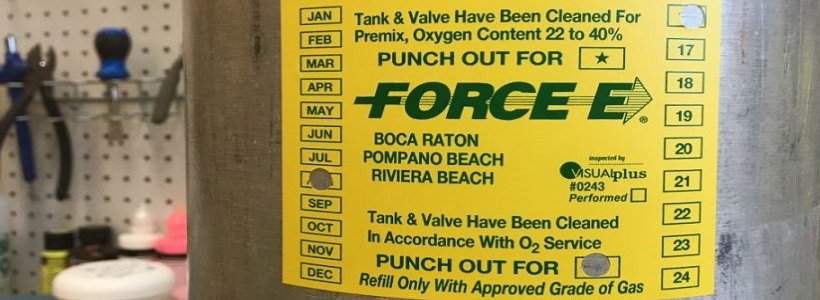Your SCUBA Tank Is A VIP – Don’t Forget Its Annual Inspection
- Posted on
- By Melissa Johnson
- Posted in Scuba Gear, Scuba Tips

For many Florida divers, it is easy to find excuses to postpone the responsibilities of diving. Sending in your gear for an annual service and inspection may be missed when the sunshine is calling. This year, don’t forget the most overlooked (and arguably important) piece of diving equipment – your scuba tank.
Just like your regulator, BC and computer, your scuba cylinder requires an annual checkup, too. As a full service center, Force-E can make sure that your gear stays in tip-top condition, and receives the care and attention it requires.

Every scuba tank that you use should be marked with a VIP, or Visual Inspection, sticker. The VIP sticker should feature the name of the last shop that performed the last inspection, as well as the month and year in which it took place. Each VIP is valid for a year from the date of its last inspection. Before using any scuba tank, check the VIP sticker to ensure it is up to date.
In the case of a Nitrox tank, the VIP sticker may also label your cylinder as “O2 clean.” This is an important indicator to shops like Force-E, which means that your tank meets special standards required during partial pressure blending. (Partial pressure blending refers to your tank being filled first with pure oxygen, and then topped off with air to create a Nitrox mix. Learn more by becoming a Nitrox certified diver!).
If your tank is marked as O2 clean, always check to verify that the next VIP sticker placed on your tank will still contain these markings. If a scuba center will not maintain your tank’s O2 clean status during their inspection, it is advisable to find a different shop that will. Without that marking, any center that uses partial pressure blending will be unable to fill your cylinder. O2 cleaning a tank because its status wasn't maintained is a costly, time consuming process that's easy to avoid.
During a Visual Inspection, a technician will remove the valve from your tank and look inside. The technician is checking to ensure the inside of the cylinder is free of water, rust, cracks and foreign objects.

Next, the technician uses a tool to magnify the threads on the neck of your tank. They are again looking for rust, cracks, or other signs of damage that may compromise the strength of the cylinder.
If the inside of your tank passes inspection, the technician will then check the outside. This includes removing the tank boot. They are looking for significant rust and chips beyond minor marks usually incurred during normal wear and tear. If your tank comes back missing a sticker or area of paint, that means you had a good technician! Stickers, tank boots and paint may trap salt water against your cylinder, which can cause quicker degradation.
Once your cylinder checks out, your tank valve is inspected next. O-rings are replaced, and the threads on the valve are properly lubricated. If you notice any problems with your tank valve, like handles that are hard to turn, let your technician know.

After the technician inspects the valve, they will secure it back onto your tank and apply an updated VIP sticker. These stickers come in a variety of shapes, sizes and colors. Checking the VIP sticker on any tank you rent is a great way to familiarize yourself with these important indicators.
Don’t forget, while a VIP is performed every year, each tank also requires hydrostatic testing every 5 years. You will find the “hydro” date stamped into the metal of your tank. It includes a 2-digit indicator for both the month and year of your cylinder’s last hydrostatic test.
Have questions about your scuba tank, the inspection process, or your gear? Just come in and ask us! Force-E staff are passionate about diving. It has taken us years to gain the knowledge of industry professionals, and we love to pass along our learning.
See ya under water soon!
